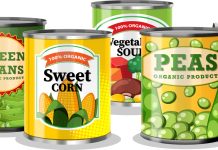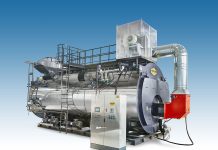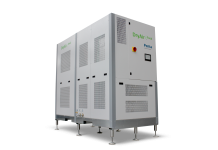 Water removal from food matrixes represents one of the oldest techniques to ensure food stability. Nevertheless, the quality of dehydrated food is strongly affected by processing and preservation conditions which, sometimes, can irreparably alter the chemical, physical and nutritional features of food. Freeze-drying provides an alternative approach for moisture removal: it consists of a dehydration process, where water is removed through sublimation from a frozen product. Thanks to the relative absence of liquid water and the low temperature, most of microbiological reactions and alterations are stopped, ensuring very high quality products. Nonetheless, freeze-drying has been always considered as an expensive technique, whose use in the food industry is limited to food matrixes otherwise difficult to dry and/or characterized by high commercial value. Among these: baby foods, nutraceutical products, seasonal and highly perishable raw materials, coffee, spices and pot-herbs, for which it is essential to preserve nutritional and organoleptic features. As it is well-known, the freeze-drying process is technically divided into three main stages: freezing, primary drying (or sublimation), and secondary drying (or desorption); before such steps, it is fundamental to know or investigate the formulation of the products to be treated. According to their composition, matrixes can have one, more or no eutectic points, i.e. the point where temperature and pressure values allow a frozen solid to sublimate without passing through the liquid state. The peculiarity of the freeze-drying technique consists in reaching minimum moisture levels (generally 0.5-2%), achieved in absence of air, while maintaining food at a temperature ranging from -40 to -20°C, during sublimation, and not exceeding 20–25°C during the final phase. Besides ensuring the slowdown of degrading reactions, this allows to protect the contents, both in heat-labile compounds (vitamins) and in volatile molecules (aroma). Unlike conventional hot air drying, where high temperatures cause browning and pigment alteration, the freeze-drying process also preserves the original color. Moreover, water removal can alter food physical properties and determine secondary effects, such as shrinking, deformation, and compaction. However, the presence of water at solid status during the freeze-drying process consents to protect structure and shape of the product inducing a small volume reduction.
Water removal from food matrixes represents one of the oldest techniques to ensure food stability. Nevertheless, the quality of dehydrated food is strongly affected by processing and preservation conditions which, sometimes, can irreparably alter the chemical, physical and nutritional features of food. Freeze-drying provides an alternative approach for moisture removal: it consists of a dehydration process, where water is removed through sublimation from a frozen product. Thanks to the relative absence of liquid water and the low temperature, most of microbiological reactions and alterations are stopped, ensuring very high quality products. Nonetheless, freeze-drying has been always considered as an expensive technique, whose use in the food industry is limited to food matrixes otherwise difficult to dry and/or characterized by high commercial value. Among these: baby foods, nutraceutical products, seasonal and highly perishable raw materials, coffee, spices and pot-herbs, for which it is essential to preserve nutritional and organoleptic features. As it is well-known, the freeze-drying process is technically divided into three main stages: freezing, primary drying (or sublimation), and secondary drying (or desorption); before such steps, it is fundamental to know or investigate the formulation of the products to be treated. According to their composition, matrixes can have one, more or no eutectic points, i.e. the point where temperature and pressure values allow a frozen solid to sublimate without passing through the liquid state. The peculiarity of the freeze-drying technique consists in reaching minimum moisture levels (generally 0.5-2%), achieved in absence of air, while maintaining food at a temperature ranging from -40 to -20°C, during sublimation, and not exceeding 20–25°C during the final phase. Besides ensuring the slowdown of degrading reactions, this allows to protect the contents, both in heat-labile compounds (vitamins) and in volatile molecules (aroma). Unlike conventional hot air drying, where high temperatures cause browning and pigment alteration, the freeze-drying process also preserves the original color. Moreover, water removal can alter food physical properties and determine secondary effects, such as shrinking, deformation, and compaction. However, the presence of water at solid status during the freeze-drying process consents to protect structure and shape of the product inducing a small volume reduction.
Some critical points
 The food is, therefore, porous, light, with uniform texture and rehydration speed 4-6 times higher than the same product dried through traditional air methods. The advantages of the freeze-drying process involve also storage and distribution phases. As a matter of fact, treated food is easily transportable: it can be maintained at room temperature, provided that they are stored in airtight, anti-oxidation and anti-humidity containers. Despite the excellent quality of obtained products, choosing freeze-drying as preservation technique shows some critical points. Among these, the duration of the drying cycle varies according to product and operational conditions, but generally requires from 8 to 24 hours. This results in a great incidence of energy costs, necessary to maintain set vacuum and refrigeration levels and to determine state change and water desorption. Traditional air drying implies reduced costs; however the product quality is significantly limited, as well. It is known that the quality features of food are preserved by low operating temperatures, which can also be found in refrigerated, frozen, and quick-frozen food products. Therefore, the energy request for this kind of products has to be extended to logistics and home storage: the cold chain has to be necessarily maintained with resulting further energy consumption. Comparing the cost items associated to the dehydration of matrixes with different commercial value, it is important to note how the energy spent in the freeze-drying process itself becomes insignificant when dealing with high-value raw materials. Investment costs account for a significant part of the expense items, but, of course, they depend on multiple factors, including system type and required production volume. The available – and most commonly deployed – equipment are single cabinet batch type, with freeze drying of the product in trays. They are able to produce up to 500-600 kg output in 24 hours. The output discontinuity which derives from such treatment can be largely solved by using two or more units programmed to operate with staggered, overlapping drying cycles in multicabinet batch plants. Tunnel-type freeze dryers are less wide-spread but more flexible in terms of production: the product is disposed on shelves, loaded on trolleys and inserted into a drying chamber. The increasing need for continuous functioning plants can be met, in particular, by modern productive technologies which allow to insert and extract food from the drying tunnel without altering either vacuum conditions or temperature. ConradTM-type systems allow achieving 1500-6500 kg of finished products in 24 hours, depending on the dry matter content, ensuring 98% efficiency. As for the treatment of liquid matrixes, such as milk, extracts or infusions, specific equipments (vacuum spray freeze dryers) are available: food is sprayed in low-temperature vacuum chambers and undergoes a first dehydration. Still wet, dust is collected and conveyed in freeze-drying tunnels, where heated plates deliver the necessary latent heat to complete the drying process. Regardless of product and plant used, the freeze-drying process consists of the above-mentioned operational steps, each of them contribute to increase energy costs. The analysis of consumptions underlines that the freezing phase has a slight influence on costs (4%); both condensation and vacuum generation account for 25% while sublimation latent heat uses 45% of the total needed energy.
The food is, therefore, porous, light, with uniform texture and rehydration speed 4-6 times higher than the same product dried through traditional air methods. The advantages of the freeze-drying process involve also storage and distribution phases. As a matter of fact, treated food is easily transportable: it can be maintained at room temperature, provided that they are stored in airtight, anti-oxidation and anti-humidity containers. Despite the excellent quality of obtained products, choosing freeze-drying as preservation technique shows some critical points. Among these, the duration of the drying cycle varies according to product and operational conditions, but generally requires from 8 to 24 hours. This results in a great incidence of energy costs, necessary to maintain set vacuum and refrigeration levels and to determine state change and water desorption. Traditional air drying implies reduced costs; however the product quality is significantly limited, as well. It is known that the quality features of food are preserved by low operating temperatures, which can also be found in refrigerated, frozen, and quick-frozen food products. Therefore, the energy request for this kind of products has to be extended to logistics and home storage: the cold chain has to be necessarily maintained with resulting further energy consumption. Comparing the cost items associated to the dehydration of matrixes with different commercial value, it is important to note how the energy spent in the freeze-drying process itself becomes insignificant when dealing with high-value raw materials. Investment costs account for a significant part of the expense items, but, of course, they depend on multiple factors, including system type and required production volume. The available – and most commonly deployed – equipment are single cabinet batch type, with freeze drying of the product in trays. They are able to produce up to 500-600 kg output in 24 hours. The output discontinuity which derives from such treatment can be largely solved by using two or more units programmed to operate with staggered, overlapping drying cycles in multicabinet batch plants. Tunnel-type freeze dryers are less wide-spread but more flexible in terms of production: the product is disposed on shelves, loaded on trolleys and inserted into a drying chamber. The increasing need for continuous functioning plants can be met, in particular, by modern productive technologies which allow to insert and extract food from the drying tunnel without altering either vacuum conditions or temperature. ConradTM-type systems allow achieving 1500-6500 kg of finished products in 24 hours, depending on the dry matter content, ensuring 98% efficiency. As for the treatment of liquid matrixes, such as milk, extracts or infusions, specific equipments (vacuum spray freeze dryers) are available: food is sprayed in low-temperature vacuum chambers and undergoes a first dehydration. Still wet, dust is collected and conveyed in freeze-drying tunnels, where heated plates deliver the necessary latent heat to complete the drying process. Regardless of product and plant used, the freeze-drying process consists of the above-mentioned operational steps, each of them contribute to increase energy costs. The analysis of consumptions underlines that the freezing phase has a slight influence on costs (4%); both condensation and vacuum generation account for 25% while sublimation latent heat uses 45% of the total needed energy.
Reducing treatment times
All possible actions aiming to increase energy savings in freeze-drying techniques have to take in proper consideration this spending division. Therefore, developments in this area mainly focus on reducing treatment times, by identifying alternative methods to promote heat transfer during sublimation. Among the available solutions, the use of microwaves significantly accelerates the rate of drying, since supplied energy is mainly absorbed by the humid area of frozen products, characterized by high thermal conductivity. Despite all apparent advantages, the use of microwaves in industrial freeze-drying is not very wide-spread: besides being expensive, this process is technically complex and difficult to control. Even the use of absorbing materials for water vapor removal – instead of condensers – implies a cost cut which is associated to a food quality decay. Deploying de-icing systems functioning at low pressure represents a valid solution for cutting consumptions, since it avoids the need of setting vacuum at every work cycle. A further technique has recently been developed on the basis of Dalton’s law of partial pressures: it implies the creation of a continuous freeze-drying process performed at atmospheric pressure. Despite the energy saving deriving from the absence of vacuum generating pumps, the quality of end products is not always ensured, and working times are often higher than those of the traditional process. The modern food system requires a greater preservation of nutritional, organoleptic and healthy features of the offered products. If freeze-drying provides food with a significant added value or broadens its high quality parameters, it mustn’t be considered as a mere preservation process with prohibitive costs. Energy saving is a common goal for sector companies and can be achieved by optimizing process performances. As a matter of fact, there are several models developed to define and monitor operational conditions, in order to minimize times and ensure quality, without waste. Higher awareness of technique potentials and continuous enhancement of energy performances can turn freeze-dried food products from “astronauts’ food” into the “food of the future”.
by Roberta Dordoni – Institute of Oenology and Agro-Food Engineering, Università Cattolica del Sacro Cuore, Piacenza



